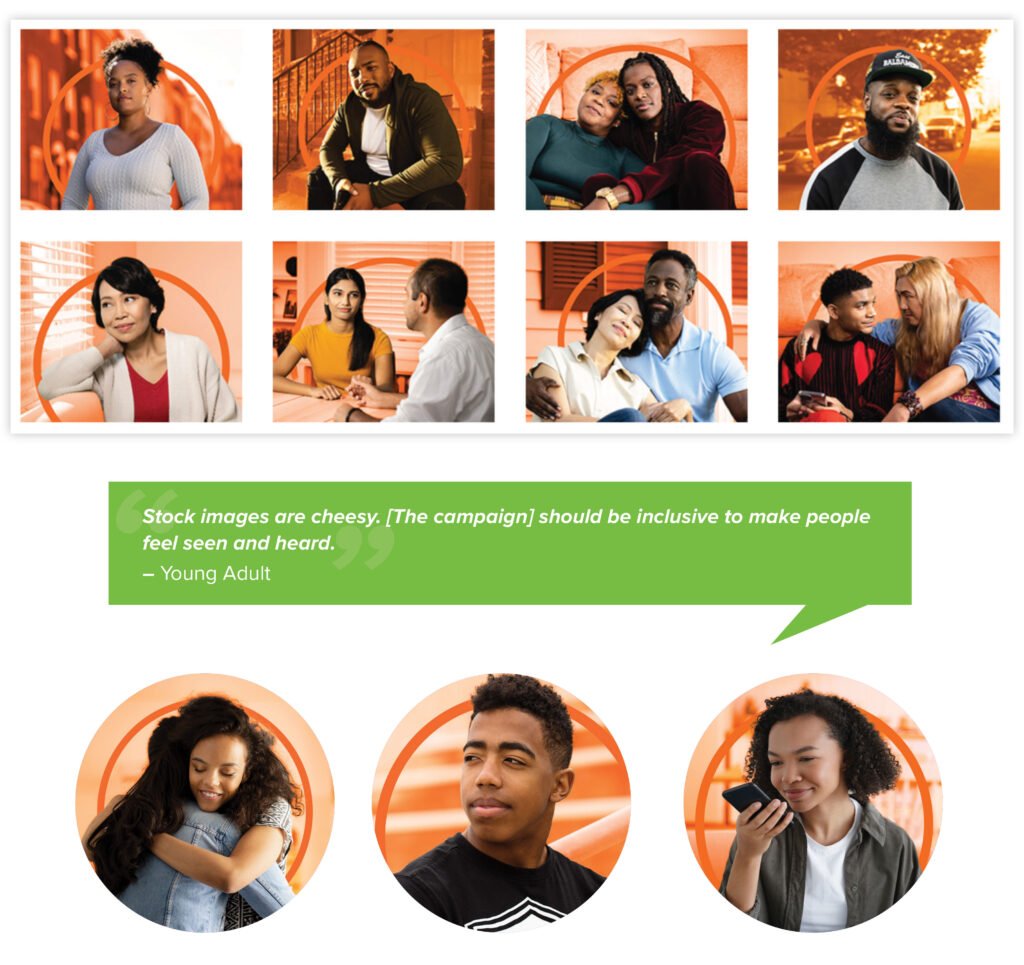The Insights Center features ideas, tools and resources on applying behavioral science to causes worth caring about. It includes the tools and thinking developed over nearly two decades of building behavior change campaigns and products. We hope they help you and your cause with the art and science of using behavior to spark real change.
Go
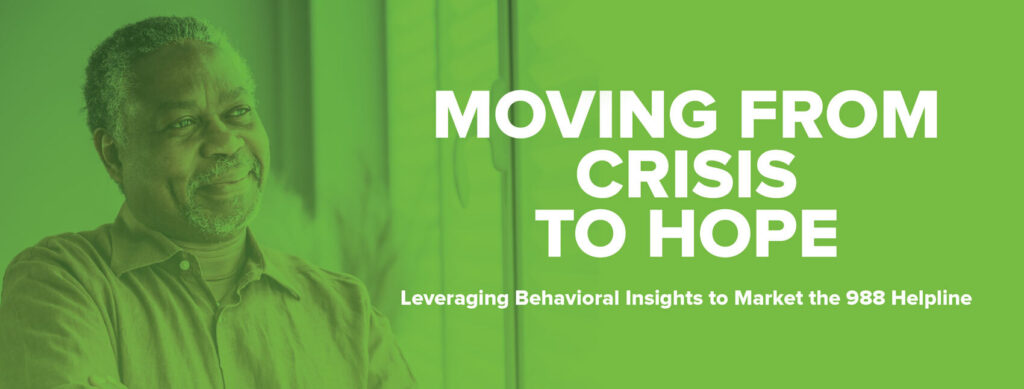
By Sara Isaac and Francis Diaz Kennedy
What influences people’s willingness to call the 988 suicide prevention helpline?
Since August 2021, Marketing for Change has conducted in-depth audience research to answer that question for Behavioral Health System Baltimore, Inc. (BHSB) in Central Maryland. Our work has uncovered five key behavioral insights that communities can leverage to increase 988 engagement and trust.
Marketing for Change has used these behavioral insights to inform our development of BHSB’s CALL 988 campaign, which has successfully engaged priority audiences including veterans and older men, youth ages 13 to 24, LGBTQIA+ residents, and people experiencing a mental health emergency. This year, we expanded our 988 support to three other states.
The national 988 helpline was rolled out with urgency in July 2022 to address the country’s alarming rates of suicide. It is still in early stages of development. Monica Johnson, director of the 988 & Behavioral Health Crisis Coordinating Office at the Substance Abuse and Mental Health Services Administration, told a recent webinar of community providers and partners, “We are building the plane as we fly it.”
This white paper is intended to help 988 outreach efforts across the country as we build that plane together. Marketing for Change and BHSB are sharing our research insights and creative examples to help communities design effective engagement campaigns. Our hope is that together we can encourage more Americans to contact 988, find relief, restore hope, and enjoy mentally healthy lives.
SAMHSA’s 988 research
In November 2023, the Substance Abuse and Mental Health Services Administration (SAMHSA) released Messaging and Communications to People at Higher Risk for or Disproportionately Impacted by Suicide, the first in a planned series of reports on 988 insights and message testing. Importantly, SAMHSA’s findings track closely with the research that M4C has conducted since August 2021.
We are excited to build on SAMHSA’s work by contributing insights from our own research as well as examples from our creative campaigns that demonstrate how high-level insights can be translated into marketing efforts targeted to specific locations and audiences.
Background
In the United States, someone dies by suicide every 11 minutes. Suicide is the second leading cause of death among people aged 10 to 341 and it takes the lives of nearly 17 veterans each day.2 A 2019 report from the U.S. Centers for Disease Control and Prevention found that one in three high school students and half of female students reported persistent feelings of sadness or hopelessness—an overall increase of 40% from 2009. In September 2023, Surgeon General Dr. Vivek Murthy and six of his predecessors gathered at Dartmouth University to sound the alarm, calling the nation’s mental health crisis a threat to democracy.
In July 2022, the 988 Suicide & Crisis Lifeline was rolled out nationwide. It is an easy to remember number that works nationwide. Like 911 for law enforcement, 988 is a national number with local response. Calls to the Lifeline are routed to the nearest call center. This means that someone experiencing a mental health emergency can easily access immediate help.
While the rollout of 988 was mandated nationally, responsibility for funding and implementation of local call center operations—as well as outreach and community engagement efforts—falls primarily to local and state jurisdictions. As a result some entities, like Behavioral Health System Baltimore, Inc. (BHSB), began planning for their community engagement campaign long before the 988 launch while other communities are just now getting started.
In addition to our research findings, the information in this white paper includes lessons learned from the CALL 988 outreach campaign that BHSB launched in 2022. It is intended to provide ideas and inspiration to other communities and can serve as a supplement to the federal 988 Partner Toolkit, which was released in June 2023 to provide resources that can be adapted for local use.
Who We’ve Talked To
Since December 2021, Marketing for Change has interviewed or surveyed 2,484 residents and 105 key informants / community partners in Central Maryland and the Southern U.S. This includes:
Residents
2,343 survey respondents and 141 qualitative interviews (in-depth interviews or focus groups)
Ages 13 to 89
Census-matched mix of demographics (gender, race / ethnicity, household income, education attainment)
58% reported experience with mental health or substance use concerns
1 in 5 reported thinking about or attempting suicide
Key Informants and Community Partners
29 qualitative interviews and 76 survey respondents
Behavioral insights for 988 outreach
Marketing for Change uses a Behavioral Determinants Framework to identify key insights from behavioral science that we can apply to our behavior change work. Our formative research and message testing are designed to surface the most powerful factors that can influence a behavior in a particular context.
The Behavioral Determinants Framework incorporates foundational theories from social psychology along with proven cognitive biases from behavioral science. The Framework ensures we ask the right questions to reveal which factors we can leverage to overcome barriers and motivate change.
The 988 research conducted by M4C includes insights from diverse audiences in Central Maryland and the Southern U.S. We gathered insights from people ages 13 to 89 from urban, suburban, and rural communities who had a wide variety of racial and ethnic identities, household incomes, and educational attainment.
Surprisingly, these highly distinct audiences from very different regions of the country reported remarkably similar barriers and benefits to using 988. We have distilled our research into five behavioral insights that have since been field tested in BHSB’s CALL 988 outreach campaign.
The insights from our research and outreach campaign are detailed below.
5 Key Behavioral Insights for 988 Outreach
Normalize help-seeking to reduce stigma
Behavioral determinant: Social norms
While stigma around mental health has decreased in recent years, especially among younger audiences, it continues to be a major barrier to help-seeking. From military veterans who worried they would be passed over for redeployment to the teenage varsity athlete concerned she might be pulled off her team, many research participants feared that asking for help would make them appear unstable in the eyes of others.
However, we also found that normalizing help-seeking reduces stigma and increases willingness to use 988. Audiences of all ages and genders responded positively to messages such as “everyone needs help sometimes.” Focusing on commonly experienced mental health conditions, rather than the more abstract “mental health,” also helped many participants perceive the helpline as more personally relevant.
What works
- Using concrete, everyday language about specific and more common mental health concerns such as “anxiety,” “feeling down,” or “grieving.” This felt more personally relevant than “mental health.”
- Separating mental health and substance use messaging. While stigma exists around mental health, it is much higher for substance use. Combined messages can make people with mental health concerns feel like 988 is “not for me.”
- Offering “emotional support,” which feels more ordinary and is less stigmatized than “mental health support.”
- Saying “experiencing” instead of “struggling.” Men and women reacted negatively to the use of struggling: “You’re telling me I am weak.”
- Emphasizing confidentiality. Fear of being found out is a major barrier to calling. Over and over, participants feared that a conversation with 988 would somehow be shared with friends, family members, schoolmates, or employers. Let them know calls will be kept private.
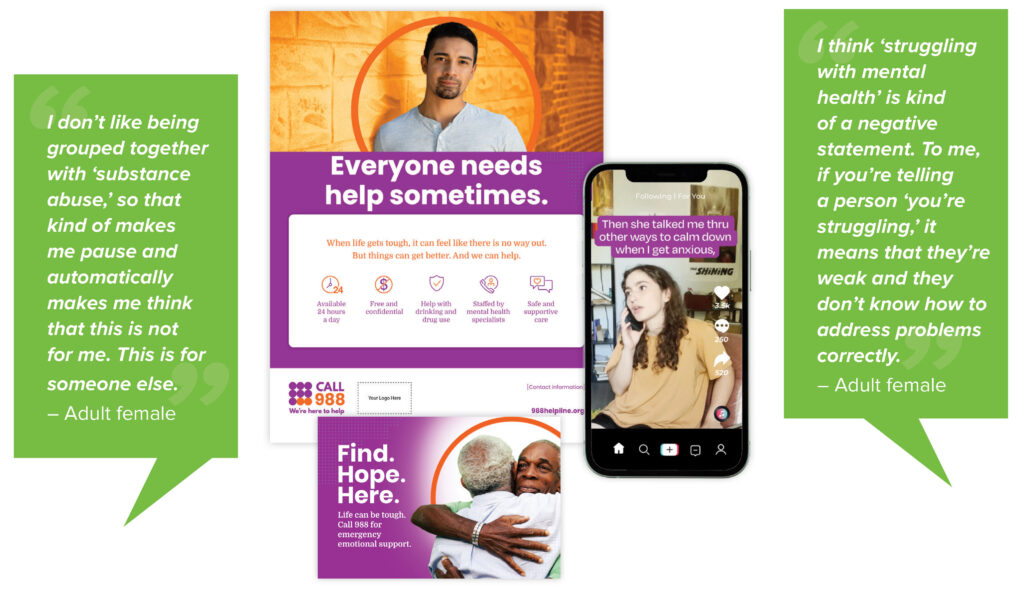
Lower the stakes of engagement
Behavioral determinant: Self-perception theory (“foot in the door”)
The purpose of the 988 helpline is to reach people in crisis to prevent suicide. However, participants told us that a crisis felt overwhelming and chaotic—“like a zombie attack or 9/11”—while an emergency was something an ordinary person could address.
Defining 988 as a crisis line and focusing on suicide also made some people with emotional concerns question whether their problems were big enough to merit a call. Conversely, messaging that focused more generally on help-seeking increased willingness to engage with 988, especially for young people with lived experience with suicidal thoughts and actions.
What works
- Using “emergency” instead of “crisis.” Respondents also responded more positively to “helpline” instead of crisis line.
- Making suicide one of many reasons to contact 988. Putting suicide front and center in messaging can unintentionally increase barriers to reaching out. However, if you want to encourage people to contact 988 for any reason, it’s important to monitor your call center response times to ensure you have the capacity to answer emergency calls quickly.
- Creating lower-stakes opportunities for engagement, such as audience-specific website landing pages with tips for coping with common emotional concerns.
- Encouraging texts or chats as well as calls. People recognize calling is likely to be more helpful but it can feel like too big of a first step.
- Encouraging calling for a friend or loved one. Many participants, especially youth, were motivated to help others. Calling for another person can also provide cover for those who want to try out the helpline before opening up.

Focus on what people want to feel right now
Behavioral determinants: Hyperbolic discounting
A core tenet of behavior change marketing is “exchange theory,” which was adapted from commercial marketing. In essence, you must give people something they really want to get them to adopt your target behavior.
Behavioral economics experiments show that people are more motivated by smaller, more immediate rewards than bigger
rewards that will come later (a bias known as hyperbolic discounting). Although crisis support and suicide prevention are the core mission of 988, many callers need more specific and immediate benefits to make it worthwhile to pick up the phone.
Top motivators uncovered in our research included the immediate relief that most people experience after calling. Other important benefits were feeling a sense of connection with another human being and hope that things can get better.
What works
- Focusing on what people want to feel rather than what you think they need to know. Behavioral science shows us that emotion, not logic, drives a majority of human decisions.
- Offering relief, connection, and hope. These three benefits were what participants most wanted to experience if they called. However, it’s important to avoid overpromising. People hope calling 988 will help them feel better and give them strategies for coping, but they know it will take more than a single conversation to resolve their concerns.
- Using hopeful imagery and colors. Image testing showed that despairing pictures and subdued colors sparked the “ostrich effect”—a tendency to ignore problems that seem too overwhelming. Note, however, that overly happy images can seem like they are overpromising or unrealistic.
- Prominently featuring call center operators. Potential callers want to know that their call will be answered by a caring specialist who can offer personal support. Call center operators, by nature, are deeply compassionate people. Featuring them in audio and visual clips can help introduce them to their community
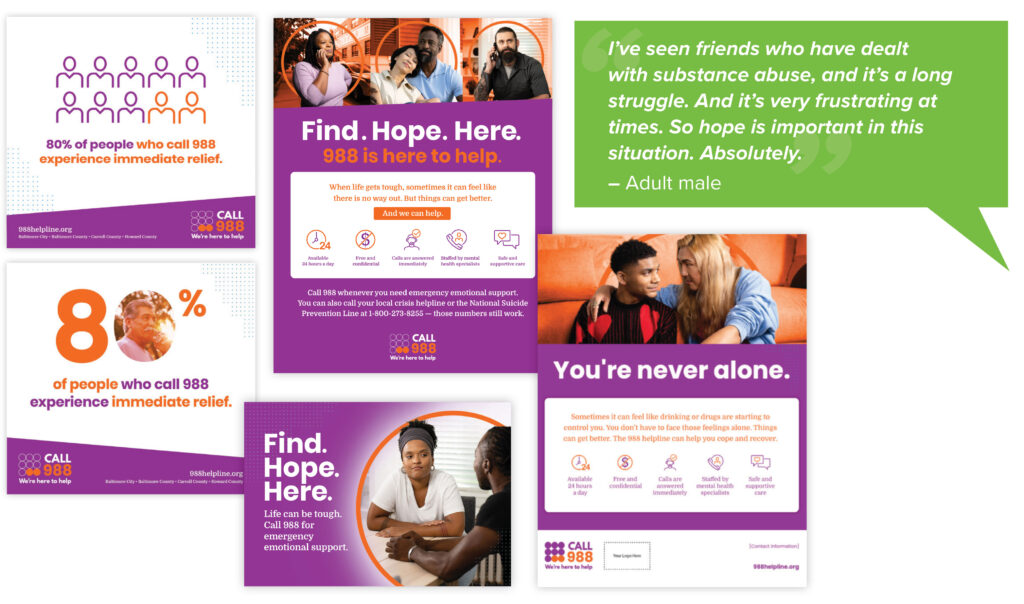
Help people know what to expect if they call
Behavioral determinant: Uncertainty effect
Humans hate uncertainty. Across all audience segments, a key barrier to calling was simply not knowing what to expect. Most people do not have a mental model for what a call experience might be like, so they worry about unknowns and unintended consequences.
Another major barrier for participants was the worry that they could face the dehumanizing experience of being put on hold, especially at such a vulnerable time.
Others had more concrete fears that the police might be called or they could be involuntarily hospitalized. Some participants—especially those who had experienced discrimination or who had had negative prior experiences with social systems—feared their concerns would be judged or dismissed.
What works
- Helping people understand what the call experience will be like. Create graphics that succinctly show each step of the process, or use video of call center operators explaining the process.
- Highlighting confidentiality. Over and over, participants feared that a conversation with 988 would somehow be shared with friends, family members, schoolmates, or employers. Let them know calls will be kept private.
- Welcoming marginalized audiences through images and words. Ensure campaign messages and images reflect your priority audiences.
- Maintaining transparency while allaying fears. For example, in Baltimore, where distrust of law enforcement is high, it was helpful to highlight that law enforcement is brought in only 1% of the time—and only if someone’s life is in immediate danger.
- Avoiding overexplaining. Too much explanation can have a reverse effect by spotlighting concerns.
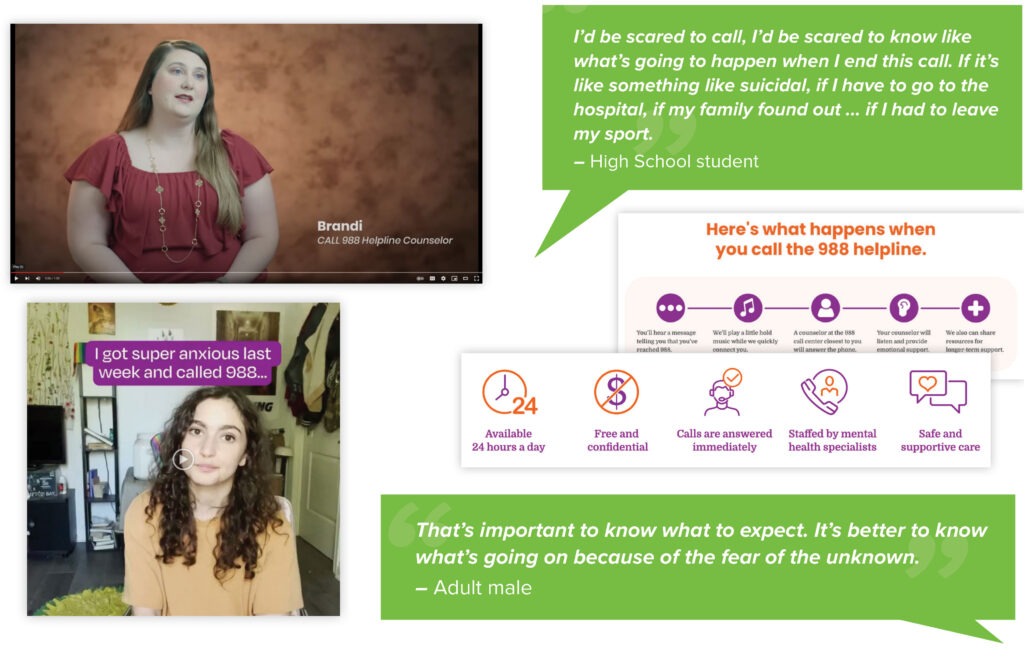
Lead with 988 but consider localizing your brand
Behavioral determinant: Messenger effect
People are more likely to believe information communicated by someone they respect or like—and the opposite is also true. The quality of the information matters far less than people’s feelings about the messenger.
A key barrier to 988 engagement, especially among marginalized communities—including residents who are Black, Indigenous, or people of color—is widespread distrust of government and fear of being unwittingly caught in “the system.”
However, distrust of government is not uniform. A recent Gallup poll found that 67% of Americans trust their local government, compared to 32% who trust Congress.
Our research has found that localizing 988 brands through images and words builds trust and engagement. For example, many Central Maryland participants responded positively to the CALL 988 logo’s purple color because it reminded them of Maryland’s professional football team, the Baltimore Ravens.
However, the benefits of localizing a community effort should be balanced with the need to build more awareness of the national number. As recently as May 2023, a year after the national launch, a Pew survey found that most Americans remain unaware of the 988 helpline.

What works
- Leading with 988 in your campaign brand to build awareness for the helpline and recall of the number.
- Localizing your brand logo by including the local or state name. You can also use images or colors that are instantly recognizable to your community’s residents.
- Conducting a photoshoot to gather authentic images that reflect your community.
- Referencing cultural touchstones in your messaging. Build on a shared social identity by leveraging phrases, events, landmarks or images that are particular to your community.
- Conducting brand testing. Whether you develop your own 988 brand or use the new national 988 Crisis & Suicide Lifeline name and logo, consider testing with local residents to chose an option that most builds trust.
